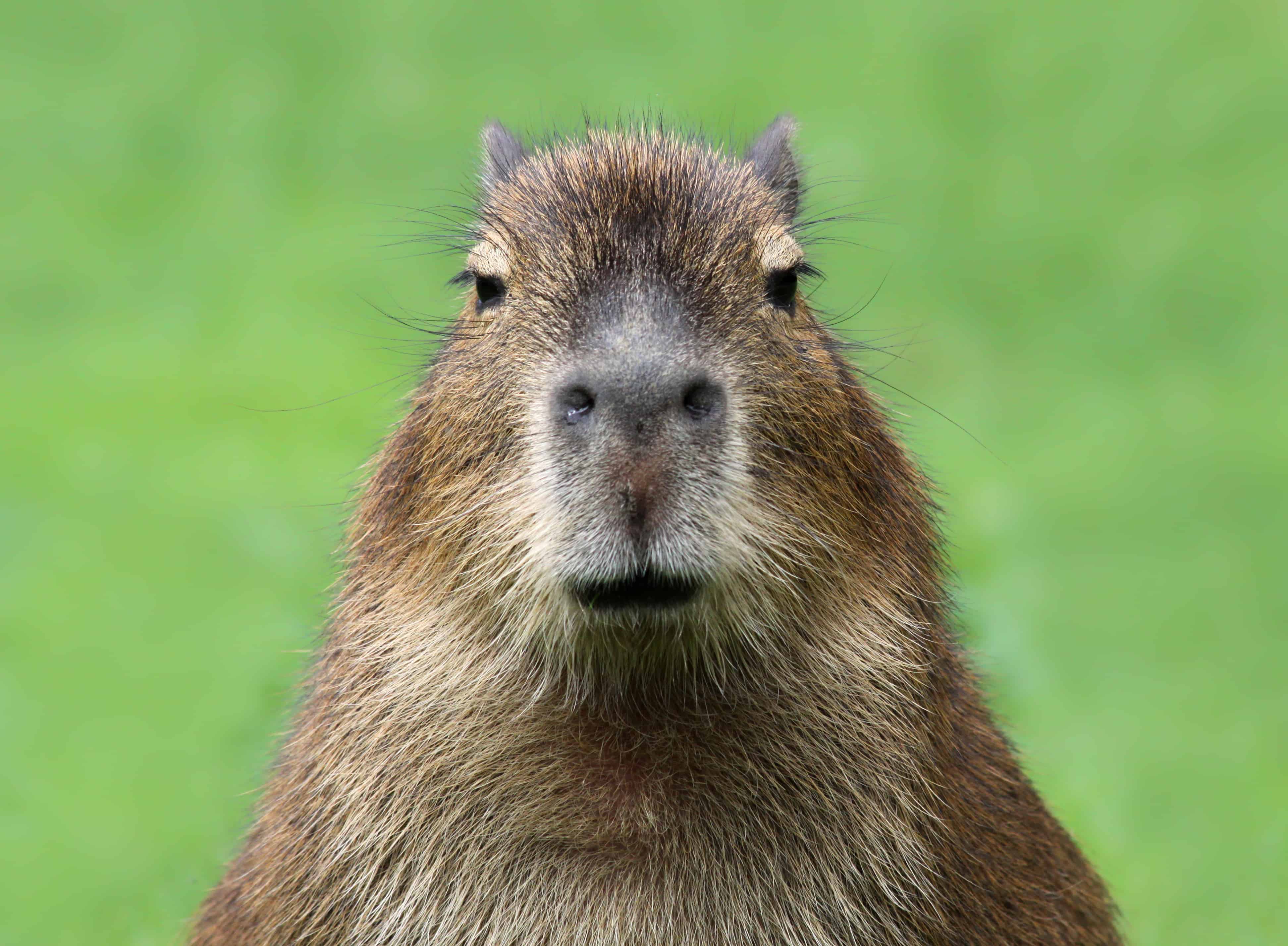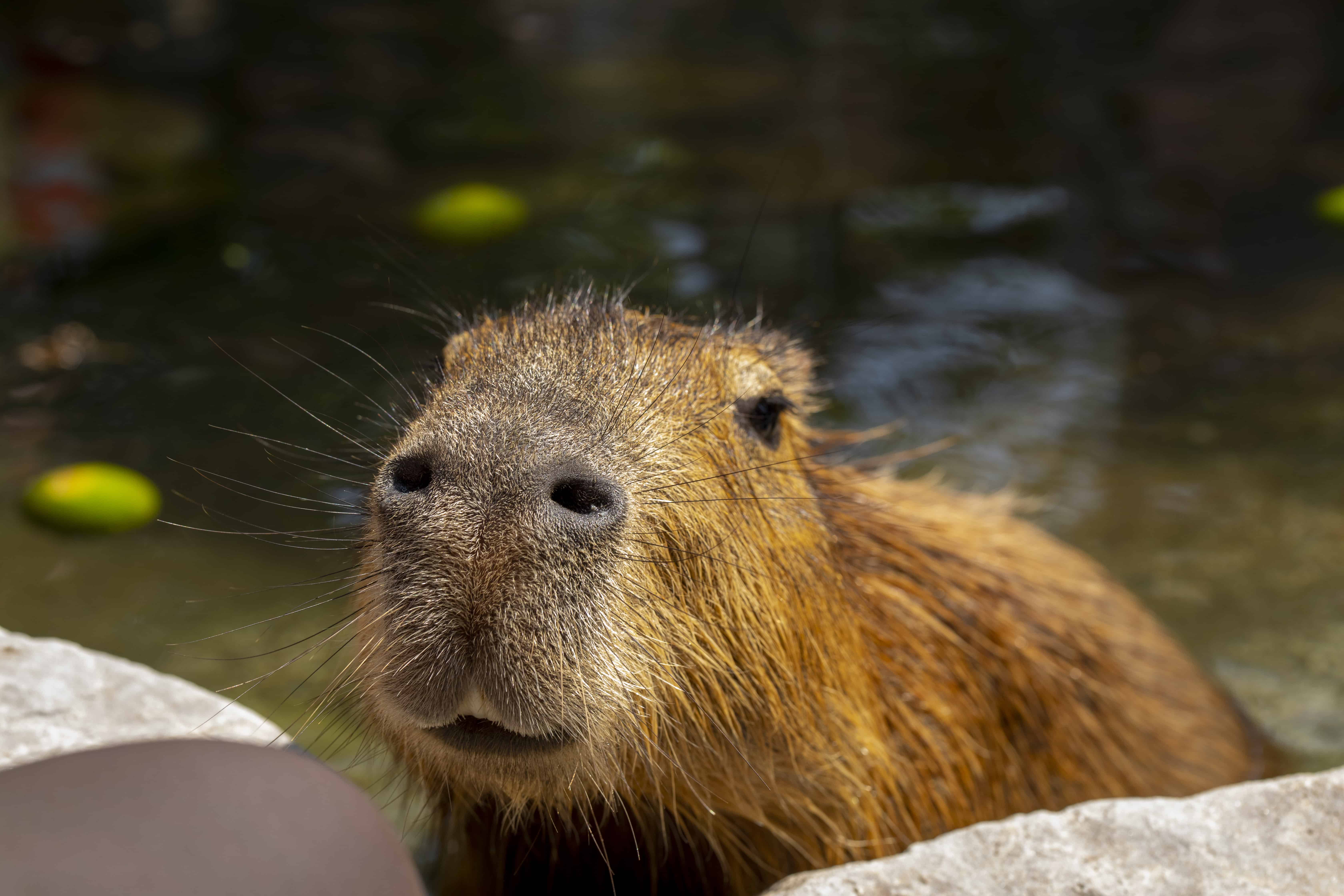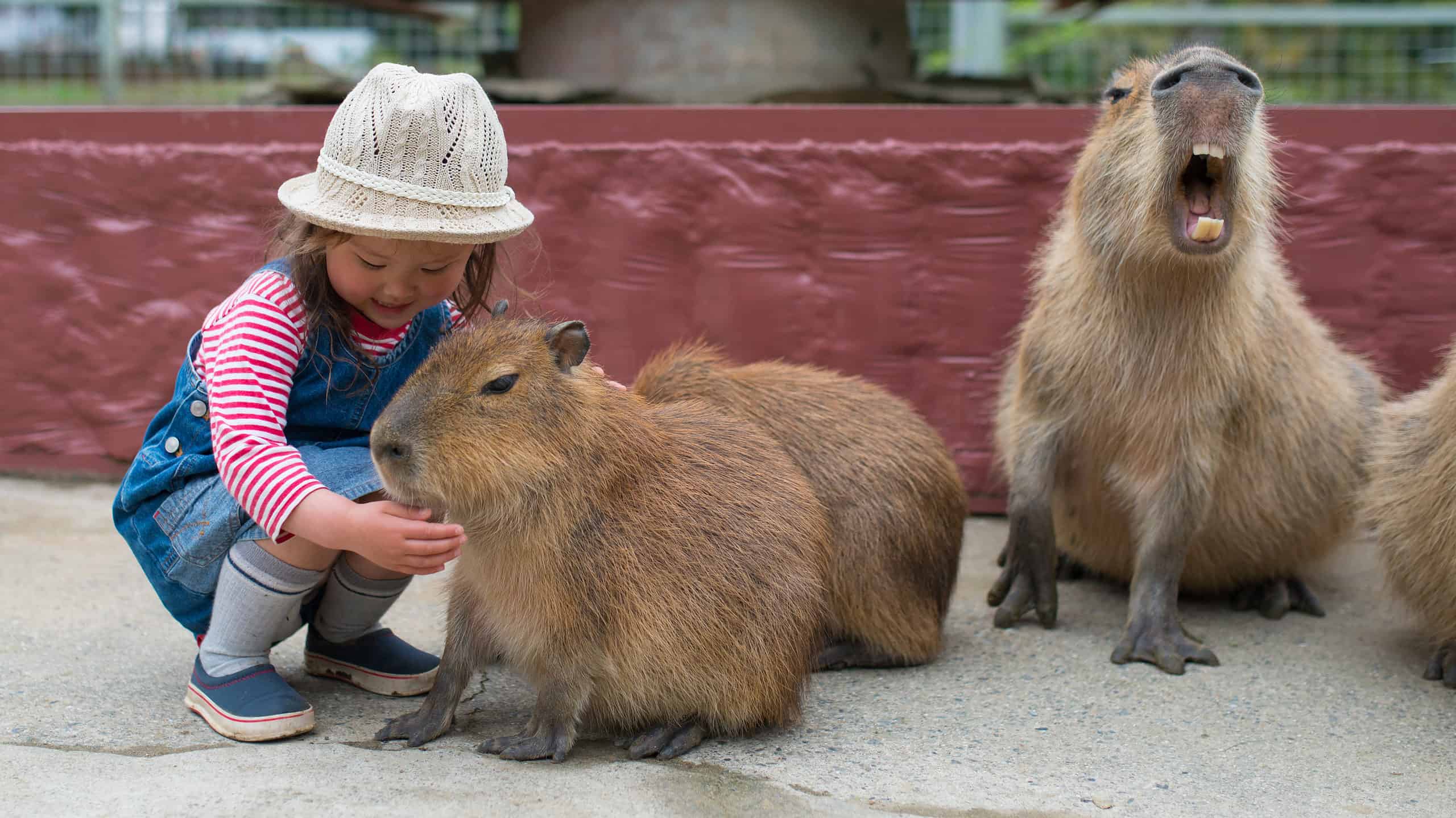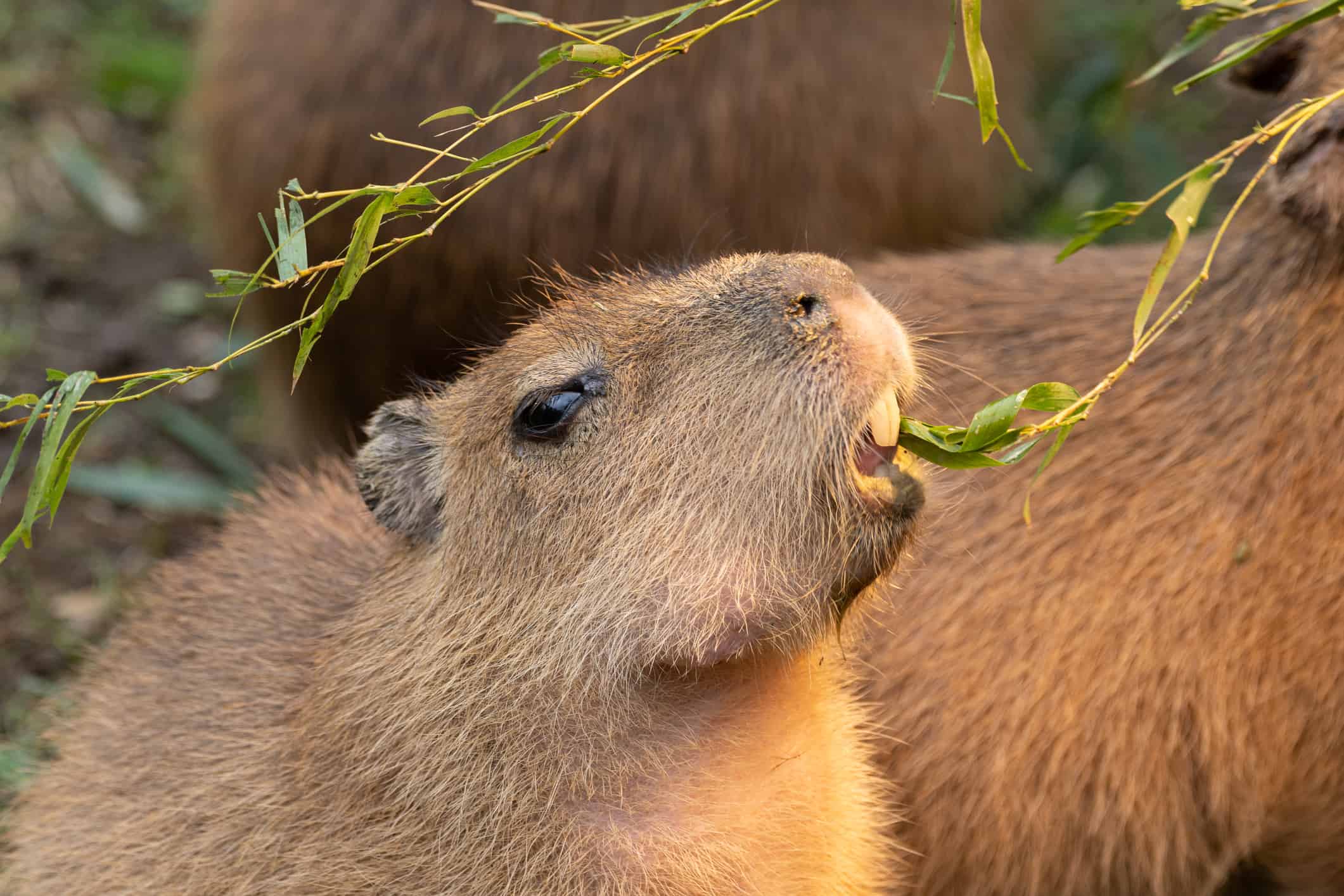There’s just something about capybaras (Hydrochoerus hydrochaeris) that people cannot get enough of. Perhaps there’s some familiarity with these mammals. They are closely related to Guinea pigs — a loveable rodent species first domesticated in South America. It could be their massive size that draws people in. Capys are the world’s largest rodent, weighing up to 154 pounds and 51 inches long.
Native to South and Central America, capybaras are semi-aquatic mammals that naturally inhabit wetlands and other bodies of water. They are uniquely equipped to handle this lifestyle. Their webbed toes are helpful for swimming, while their brittle fur helps them dry off quickly on land. In the wild, capybaras are social animals that assemble in herds of 10-30 members. These creatures are a wonderful sight to behold, making them sought after by visitors enjoying a day at the zoo. Continue reading to discover five zoos where you can witness these incredible creatures up close.
#1: Sacramento Zoo

Capybaras commonly form groups of herds comprising 10-30 individuals.
©iStock.com/tane-mahuta
The Sacramento Zoo has been a community staple in California for nearly 100 years. It originally opened in 1927 with only 40 animals on site. Now, the zoo is a top attraction, home to nearly 400 animals and 100 distinct species on 15 acres of land. This diverse group of animals includes the incredible capybara. Interestingly, the Sacramento Zoo recently welcomed an adorable capybara pup to its community over the summer. Named after one of the four Teenage Mutant Ninja Turtles, Donatello was born in late July and has impressed zookeepers with his “ninja skills,” twirling bamboo sticks in his mouth with ease. Donnie, as he is affectionately called, is the son of adult capybaras named Chigüiro and Anna-Leroy.
#2: San Diego Zoo

Capybaras are the world’s largest rodents and can weigh up to 154 pounds.
©7caina lemes26/Shutterstock.com
The San Diego Zoo is another community fixture in the California area. With plenty of tours and up-close and interactive experiences, this zoo is a must-see destination for individuals and families alike. Uniquely, the San Diego Zoo Wildlife Alliance — comprised of the San Diego Zoo and the San Diego Zoo Safari Park — merges science, education, and wildlife health and care to promote sustainability. San Diego Zoo, located in Balboa Park, is spread over 100 acres and houses 4,000 animals. The capybaras share a habitat with Baird’s tapirs and black spur-winged geese in the Elephant Odyssey section of the zoo.
#3: Jacksonville Zoo

Capybaras are semi-aquatic mammals.
©wushoung wang/Shutterstock.com
Jacksonville Zoo and Gardens sits on approximately 115 acres of land in Jacksonville, Florida. It houses more than 1,000 plant species and over 2,000 animal species. In addition, the zoo represents a host of conservation initiatives, including the International Rhino Foundation, Manatee Rescue and Rehab, the American Association of Zoo Keepers Jacksonville, and more.
The zoo and garden have big plans this holiday season, with a breathtaking display of Chinese lanterns in the form of beloved animals throughout the zoo and visits from Santa every night from December 14-24. Moreover, these nights include live music, crafts, specialty drinks, and visits and performances from iconic characters such as Santa Claus, Ice Queen, the Grinch, and more. At the Jacksonville Zoo, animal lovers can find capybara in the River’s Edge exhibit, where they coexist with other fascinating species like giant ant eaters and howler monkeys.
#4: Wild Florida Airboats and Gator Park

Capybaras are well-adapted for life in water and on land.
©Purino/Shutterstock.com
Wild Florida Airboats and Gator Park offer unforgettable experiences for nature lovers in the Florida Everglades. Whether walking through Gator Park, driving through Safari Park, or riding through the Everglades on an airboat, Wild Florida offers something adventurous for everyone. Wild Florida provides hands-on experiences with animals, including the capybara. Visitors aged eight and up can hand-feed the adorable creatures with their favorite treats for $45 per person.
#5: Cape May County Park & Zoo

Capybaras are native to South America and are closely related to Guinea pigs.
©rai/iStock via Getty Images
The Cape May County Park & Zoo is located in Middle Township, New Jersey. Originally opening in 1978, the zoo is situated on 85 acres of land. It prides itself on accessibility, providing visitors with year-round experiences free of charge. The Cape May County Zoo is open every day except for Christmas and boasts more than 550 animals and 250 unique species. In addition to this, capybara lovers would be happy to know that there are opportunities to experience these amazing creatures up close. Visitors can enjoy Capybara Encounters, an approximately 20-minute meet and greet that allows you to enter the capybaras’ habitat, learn about these interesting mammals, and feed them tasty bamboo treats. This experience costs $400 for a group of four and $75 per additional guest.
| Rank | Zoo Name | Zoo Location |
|---|---|---|
| #1 | Sacramento Zoo | Sacramento, CA |
| #2 | San Diego Zoo | San Diego, CA |
| #3 | Jacksonville Zoo | Jacksonville, FL |
| #4 | Wild Florida Airboats and Gator Park | Kenansville, FL |
| #5 | Cape May County Park & Zoo | Cape May Court House, NJ |
The photo featured at the top of this post is © Japan's Fireworks/Shutterstock.com
Thank you for reading! Have some feedback for us? Contact the AZ Animals editorial team.







